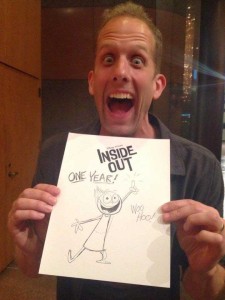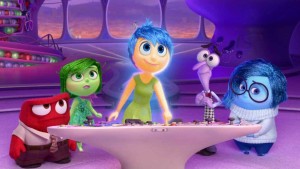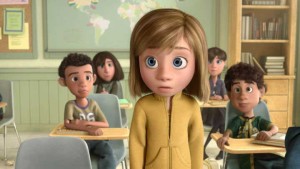![]()

The film has clearly hit emotional chords of its own, winding up on numerous Top 10 lists, and landing as a frontrunner in Oscar’s best animated film category.
For Docter, the process of developing the film was a familiar one stretching back to the studio’s earliest days in Pt. Richmond, before they wound up in their current Emeryville studio lot, back when Docter was one of the writers on the seminal Toy Story.
“After Up, I tried to think of things that would be interesting,” he said. “Then we hit on emotions.” But what about them?

It was hardly the first time an initial Pixar pitch grew into something more profound, during the studio’s vaunted development process. “If you look back – Monsters was totally different at the beginning. Up was about two princes that lived on a floating city; they fell off, and made friends with an aboriginal character.”
And similarly, things changed as radically for Inside Out. “My daughter, who was 11, was going through a big change at the time.” When Docter found himself bemoaning those changes from childlike innocence to adolescence, del Carmen, told him “look out – it gets worse.”
“Wait a minute,” he remembers thinking, “this is all related.”
From there, the idea moved into development, which “around here, lasts about a year and a half. We put together a treatment, and read that to a larger group,” which typically includes his fellow studio lynchpins like Andrew Stanton and John Lasseter. “They kick the heck out of it, with the intention of making it better.”
 After all, one of the goals is to make “emotionally relevant stories, equally compelling to us as 40 year-olds.”
After all, one of the goals is to make “emotionally relevant stories, equally compelling to us as 40 year-olds.”
With Inside Out, they appear to have succeeded, though there’s another goal to all those months of kicking. “We want to get as close as we can to a 1:1 shooting ratio. When you’re into animation it’s horribly expensive.”
That ratio is obtained by building “the equivalent of nine or 10 story reels,” Pixar’s answer to previs or animatics. In that stage “there’s a lot of experimentation.” Though not usually with the voice actors, who “we record before we animate.”
With Inside Out, though, Docter says of the cast – which included Amy Poehling, Lewis Black, Mindy Kaling and Richard Kind among its vocal luminaries – “we had so many great improv actors that goof around, we said, ‘you know what, play around with this.’ Sometimes we would use those takes.”
Though he also allows that final versions of line readings can ultimately be spliced together from several different takes, improved or not.
Besides drawing inspiration from the cast, Docter noted that at Pixar in general, “we’re talking about films that have just come out,” naming The Revenant and Spotlight as two recent favorites. The latter film “got a lot of talk around here because its exposition was handled so well.”
“At the end of the day, the job of the film that we make is the same as a live action film. It’s supposed to move them and entertain them.”
Though of course there’s never any shame or offense, he adds – two emotions that might be familiar to Inside Out’s lead character, Riley – “in saying ‘it’s a great cartoon.’”
As for Docter, his next great cartoon won’t be a follow up to this one. “I’m interested personally in moving on and doing something new. You design these characters for a specific arc. You never plan for sequels.”
So when he mentions he’s at work on a fourth Toy Story, isn’t that a sequel to the film that built Pixar? “We’ve tapped into something that’s a new direction,” he said, since he’s scarcely allowed to say more than that. “It doesn’t feel like it is part of the original trilogy.”
You can be sure they will continue to “kick the heck of the story,” en route to making another “great cartoon.”





